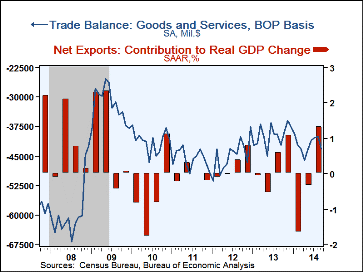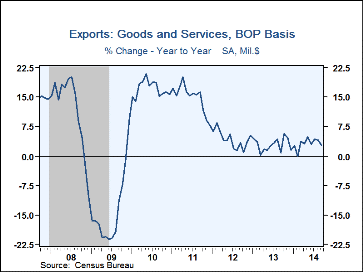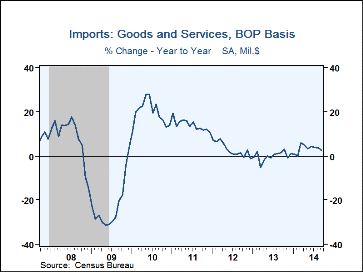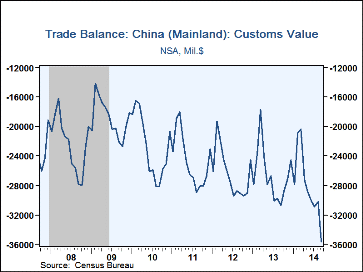 Global| Nov 04 2014
Global| Nov 04 2014U.S. Trade Deficit Deteriorates as Exports Fall
by:Tom Moeller
|in:Economy in Brief
Summary
The U.S. foreign trade deficit in goods and services widened to $43.0 billion in September from a little-revised $40.0 billion in August. Expectations in the Action Economics Forecast Survey were for $40.0 billion. Exports fell 1.5% [...]
The U.S. foreign trade deficit in goods and services widened to $43.0 billion in September from a little-revised $40.0 billion in August. Expectations in the Action Economics Forecast Survey were for $40.0 billion. Exports fell 1.5% (+2.8% y/y), the first material decline since February. Imports remained unchanged overall (2.6% y/y). Nonpetroleum imports increased 0.4% while petroleum imports were off 3.2%. This decline reflected a fall in the per barrel price of crude oil to $92.54 versus $102.00 twelve months earlier. The value of energy-related petroleum imports declined 13.3% y/y and the quantity fell 4.8% y/y.
Exports of foods, feeds & beverages increased 12.3% (-1.7% y/y), but elsewhere exports were weak. Nonauto consumer goods exports declined 4.0% (+6.0% y/y) while capital goods exports fell 2.5% (+3.0% y/y). Automotive exports slipped 0.8% (+2.7% y/y). Services exports fell 0.7% (+2.9% y/y) but travel exports declined 1.7% (+5.5% y/y). Imports also nudged 0.1% lower (+2.5% y/y) as imports of industrial supplies & materials dropped 2.0% (-4.7% y/y). Automotive imports declined 1.9% (+0.9% y/y) while capital goods imports were off 1.8% (+6.5% y/y). Working the other way, imports of foods, feeds & beverages rose 0.9% (10.8% y/y) while nonauto consumer goods imports increased 4.2% (6.0% y/y). Services imports gained 0.5% (3.0% y/y) as travel imports nudged 0.3% higher (8.2% y/y).
By country, the trade deficit with China deepened sharply to a record $35.6 billion. Imports from China jumped 11.8% y/y while exports declined 2.0% y/y. The trade deficit with Japan deepened slightly to $5.3 billion. Exports to Japan fell 2.2% y/y and imports declined 3.3% y/y. The trade deficit with the European Union deepened slightly to $11.8 billion. Exports fell 2.8% y/y but imports increased 8.0% y/y.
The international trade data can be found in Haver's USECON database. Detailed figures are available in the USINT database. The expectations figures are from the Action Economics Forecast Survey, which is carried in the AS1REPNA.
| Foreign Trade (Current Dollars) | Sep | Aug | Jul | Y/Y | 2013 | 2012 | 2011 |
|---|---|---|---|---|---|---|---|
| U.S. Trade Deficit | $43.0 bil | $40.0 bil. | $40.3 bil. | $42.3 bil. (9/13) |
$476.4 bil. | $537.6 bil. | $548.6 bil. |
| Exports (%) | -1.5 | 0.3 | 0.9 | 2.8 | 2.9 | 4.2 | 14.8 |
| Imports | 0.0 | 0.1 | 0.6 | 2.6 | 0.1 | 2.9 | 13.9 |
| Petroleum | -3.2 | -3.7 | 3.4 | -6.1 | -11.0 | -5.5 | 30.7 |
| Nonpetroleum goods | 0.4 | 0.8 | 0.2 | 6.2 | 2.0 | 5.2 | 12.1 |
Tom Moeller
AuthorMore in Author Profile »Prior to joining Haver Analytics in 2000, Mr. Moeller worked as the Economist at Chancellor Capital Management from 1985 to 1999. There, he developed comprehensive economic forecasts and interpreted economic data for equity and fixed income portfolio managers. Also at Chancellor, Mr. Moeller worked as an equity analyst and was responsible for researching and rating companies in the economically sensitive automobile and housing industries for investment in Chancellor’s equity portfolio. Prior to joining Chancellor, Mr. Moeller was an Economist at Citibank from 1979 to 1984. He also analyzed pricing behavior in the metals industry for the Council on Wage and Price Stability in Washington, D.C. In 1999, Mr. Moeller received the award for most accurate forecast from the Forecasters' Club of New York. From 1990 to 1992 he was President of the New York Association for Business Economists. Mr. Moeller earned an M.B.A. in Finance from Fordham University, where he graduated in 1987. He holds a Bachelor of Arts in Economics from George Washington University.










